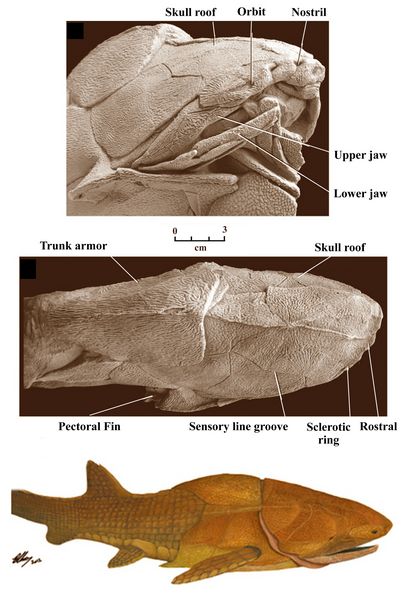Athena Review Image Archive ™
Entelognathus primordialis external form

External form of Entelognathus primordialis (after Min Zhu 2013 ).
Entelognathus primordialis is an early jawed fish from the Silurian period in China, dating from the Late Ludlow phase at 419 mya. The name comes from Entelo- "complete" and -gnathus "jaw." It belongs to the phylum Chordata and the class Placodermi.
The type specimen (V18620) was found at the Xiaoxiang reservoir in the Kuanti Formation in Qujing, Yunnan, China, and is described by Min Zhu et al. (2013). It consists of a mostly intact anterior half of an individual with the articulating head and trunk armor preserved in three dimensions. The body length of E. primordialis is estimated at over 20 cm (8 in); based on a holotype length of 11 cm (4.3 in).
E. primordialis is a placoderm (armored fish) with osteichthyan-like marginal jaw bones. It represents the first stem gnathostome with dermal marginal jaw bones (premaxilla, maxilla and dentary), features previously restricted to Osteichthyes or bony fish. Teeth are absent. The skull is composed of a series of nuchal and marginal plates, combined with orbital bones related to those of osteichthyans.
The dermal skeleton of E. primordialis
shows homologies with placoderm -osteichthyan taxa and contrasts with
that of acanthodian (spiny shark) taxa, which fall on the
chondrichthyan (cartiliginous fish) stem.
References:
Min Zhu et al. 2013; A Silurian placoderm with osteichthyan-like marginal jaw bones. Nature 502; pp.188–193.
.Copyright © 1996-2020 Rust Family Foundation (All Rights Reserved).